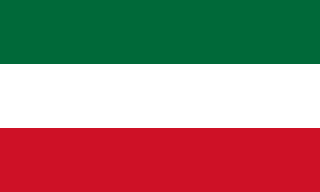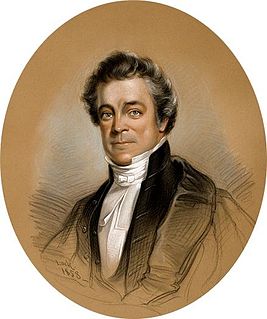
The Province of Upper Canada was a part of British Canada established in 1791 by the Kingdom of Great Britain, to govern the central third of the lands in British North America, formerly part of the Province of Quebec since 1763. Upper Canada included all of modern-day Southern Ontario and all those areas of Northern Ontario in the Pays d'en Haut which had formed part of New France, essentially the watersheds of the Ottawa River or Lakes Huron and Superior, excluding any lands within the watershed of Hudson Bay. The "upper" prefix in the name reflects its geographic position along the Great Lakes, mostly above the headwaters of the Saint Lawrence River, contrasted with Lower Canada to the northeast.

Charles Duncombe was a leader in the Upper Canada Rebellion in 1837 and subsequent Patriot War. He was an active Reform politician in the 1830s, and produced several important legislative reports on banking, lunatic asylums, and education.

Sir Francis Hincks, was a Canadian businessman, politician, and British colonial administrator. An immigrant from Ireland, he was the Co-Premier of the Province of Canada (1851–1854), Governor of Barbados (1856–1862), Governor of British Guiana (1862–1869) and Canadian Minister of Finance (1869–1873).

The Parti canadien or Parti patriote was a primarily francophone political party in what is now Quebec founded by members of the liberal elite of Lower Canada at the beginning of the 19th century. Its members were made up of liberal professionals and small-scale merchants, including François Blanchet, Pierre-Stanislas Bédard, John Neilson, Jean-Thomas Taschereau, James Stuart, Louis Bourdages, Denis-Benjamin Viger, Daniel Tracey, Edmund Bailey O'Callaghan, Andrew Stuart and Louis-Joseph Papineau.
The Railway Guarantee Act was introduced in the Parliament of the Province of Canada by Finance Minister Francis Hincks, who was also the President of the Great Western Railway of Canada. The Act encountered little opposition during the course of its passage, despite the prevailing depression.

George William Allan,, , was a Canadian lawyer and politician. He served as the 11th Mayor of Toronto and later as Speaker of the Senate of Canada.

The Bank of Upper Canada was established in 1821 under a charter granted by the legislature of Upper Canada in 1819 to a group of Kingston merchants. The charter was appropriated by the more influential Executive Councillors to the Lt. Governor, the Rev. John Strachan and William Allan, and moved to Toronto. The bank was closely associated with the group that came to be known as the Family Compact, and it formed a large part of their wealth. The association with the Family Compact and its underhanded practices made Reformers, including Mackenzie, regard the Bank of Upper Canada as a prop of the government. Complaints about the bank were a staple of Reform agitation in the 1830s because of its monopoly and aggressive legal actions against debtors.

The Bank of the People was created by radical Reform politicians James Lesslie, James Hervey Price, and Dr John Rolph in Toronto in 1835. It was founded after they failed to establish a "Provincial Loan Office" in which farmers could borrow small sums guaranteed by their land holdings. The Bank of the People was the only bank in Upper Canada not to suspend payments during the financial panic of 1837-8. Many of the shareholders, however, took part in the Rebellion of 1837 and the Family Compact plotted to have it taken over by the Bank of Montreal in 1840.

Robert Baldwin Sullivan,, was an Irish-Canadian lawyer, judge, and politician who became the second Mayor of Toronto, Upper Canada.

The Legislative Council of Upper Canada was the upper house governing the province of Upper Canada. Modelled after the British House of Lords, it was created by the Constitutional Act of 1791. It was specified that the council should consist of at least seven members. Members were appointed for life but could be dropped for non-attendance. The first nine members of the council were appointed on 12 July 1792. The speaker was usually the Chief Justice of the Court of King's Bench. The Legislative Council was dissolved on 10 February 1841 when Upper and Lower Canada were united into the Province of Canada. Some members were reappointed to the Legislative Council of the united Province.

Jonas Jones was a lawyer, judge, farmer, and political figure in Upper Canada.
Donald Macdonell of Greenfield was a political figure in Upper Canada.
Thomas Hornor was a farmer and political figure in Upper Canada.
James Lesslie was an Ontario bookseller, reform politician and newspaper publisher. His career was closely associated with - and somewhat overshadowed by - William Lyon Mackenzie, the Reform agitator, mayor of Toronto, and Rebellion leader. However, as a leader himself, Lesslie took a prominent role in founding the Mechanics Institute, the House of Refuge & Industry, the Bank of the People, as well as the political parties known as the Canadian Alliance Society and Clear Grits. In many way, he defined the Reform movement in Upper Canada without having reverted to the violent methods of Mackenzie. His legacy may thus have lasted longer.
Nathaniel Hughson was a farmer and hotel owner, a Loyalist who moved to Canada following the American Revolution, and one of the city founders of Hamilton, Ontario. Married to Rebecca Land who was the daughter of Robert Land and Phoebe Scott, both United Empire Loyalists.
The title of Chief Justice of Quebec is assumed by the chief justice of the Court of Appeal of Quebec. From 1849 to 1974 it was assumed by the Chief Justice from the Court of Queen's Bench or Court of King's Bench.

The Reform movement in Upper Canada was a political movement in British North America in the mid-19th century.

There were two types of corporations at work in the Upper Canadian economy: the legislatively chartered companies and the unregulated joint stock companies. These two business forms had different legal standing; chartered corporations had a "separate personality" - they were a legal person quite distinct from its members or shareholders, a legal fiction which protected those shareholders with limited liability. In contrast, joint stock companies were made illegal by the English Bubble Act of 1720. Joint stock companies were considered extensive partnerships under common law, and English legislation limited these to a maximum of six partners. Without incorporation, the company was not considered a "separate personality." It could not hold property; this was held by trustees, who usually had to provide a bond or security. Without incorporation, the company could neither sue nor be sued at law. And without incorporation, shareholders were personally responsible for the debts to the company to the full extent of their personal property; shareholders were not protected by limited liability. There were, then, significant legal hurdles that made the joint stock company an unwieldy form of partnership.
The Court of Appeal of Prince Edward Island is the appellate court for the Canadian province of Prince Edward Island, and thus the senior provincial court below the Supreme Court of Canada. As the number of appeals heard by the Supreme Court of Canada is extremely limited, the Court of Appeal is in practice the court of final appeal for most residents of Prince Edward Island.










